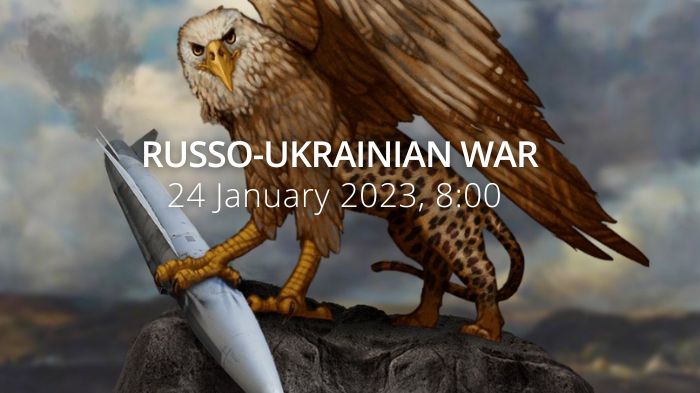Ukrainian army withdraws from Lysychansk. Russian forces launched assaults northeast of Bakhmut and north of Sloviansk. Ukrainian forces destroy the Russian military base in Melitopol. With harvest underway, Russia’s invasion continues to have a devastating impact on Ukraine’s agricultural sector. Russian ship carrying Ukrainian grain detained by Türkiye. Lukashenka accused Ukraine of shelling Belarus and ordered to "put” opponents’ capitals “at gunpoint.” Moscow blames the Ukrainian missile attack for deaths in the south Russian city.
Daily overview — Summary report, July 4
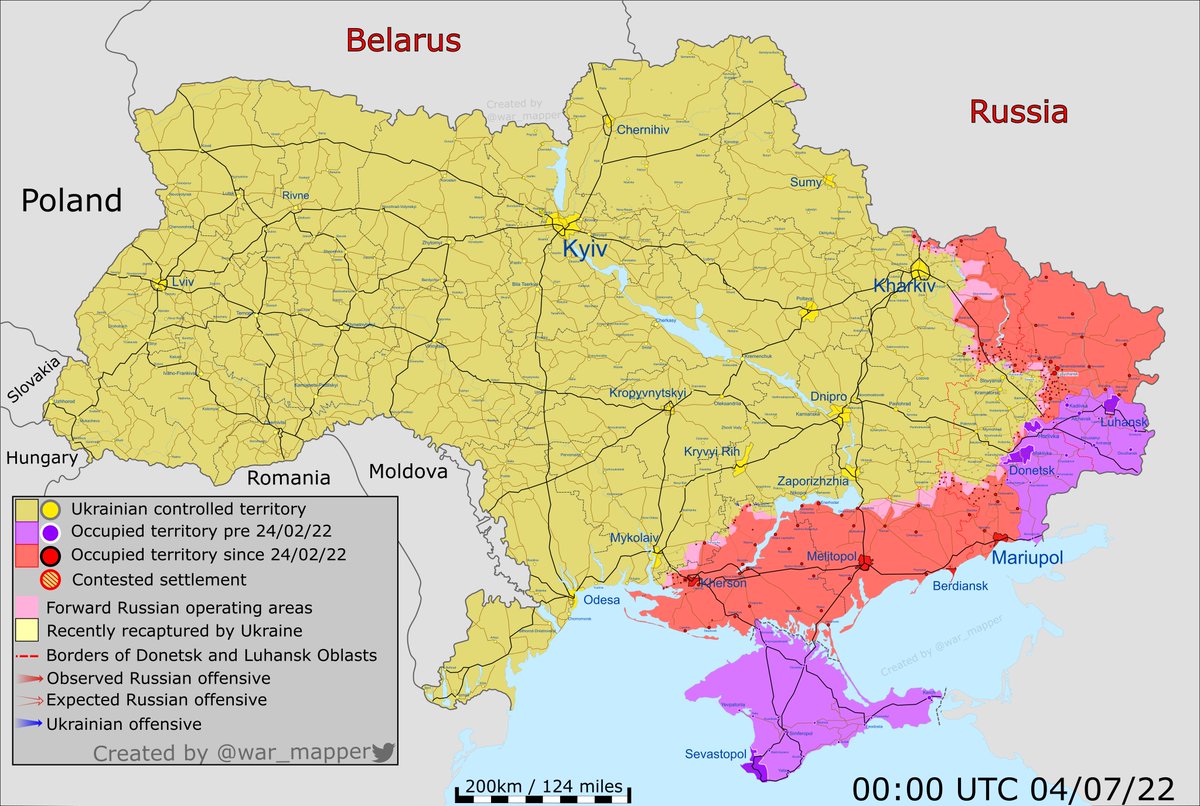
Key points of military expert Stanislav Haider's assessment of the July 4 morning:
Donetsk Oblast. In the Sloviansk direction, the Armed Forces of Ukraine repulsed the attack on Krasnopillia. Also, Russian attacks on Novoluhanske, Siversk, and Avdiivka failed as Siversk and Bakhmut stand firm. After Russia's capture of Lysychansk, Luhansk Oblast, their troops need some time to reconstitute forces. Again, gaps will be filled by units from other directions.
South of Donetsk Oblast. The Russians have strengthened their defenses in this direction to prevent Ukraine's further advance. The old T-62 tanks were already spotted here, and here they also transferred to one battalion-tactical group of mixed forces. This shows that there are big problems with making the Russian units up to strength:
"When they 'plug holes' in this way, it is simply a statement that they have completely lost even the tactical initiative," Mr. Haider says.
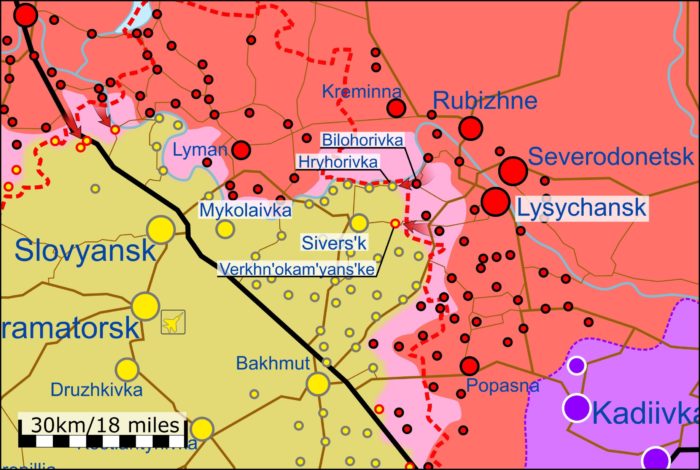
Zaporizhzhia Oblast. Ukraine focused its main forces on holding the positions and repelling the Russian assaults on them. The main battles are taking place near Nesterianka (in the direction of Vasylivka), and Polohy. Near occupied Lyubimivka (between Tokmak and Melitopol), Ukrainian guerillas blew up the bridge on a railway line used for supplying the Russian troops near Vasylivka.
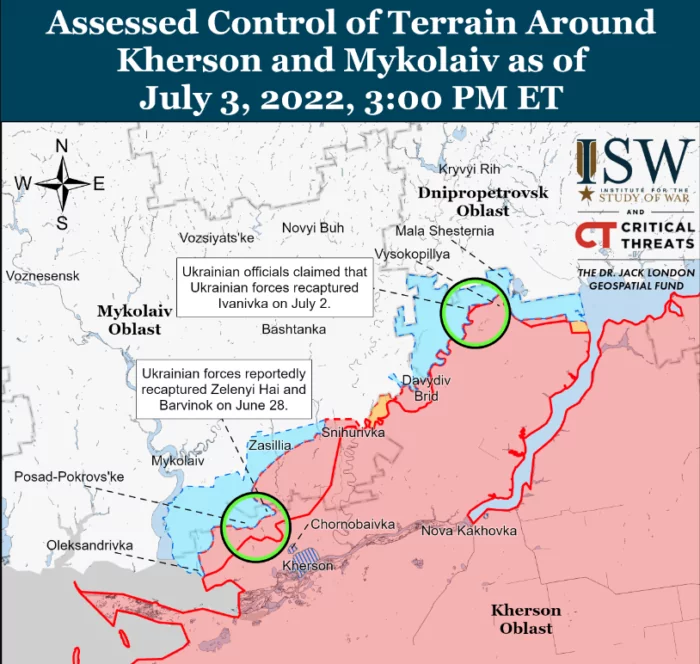
Kherson Oblast. Battles are ongoing near Snihurivka, Kyselivka, Arkhanhelske. On the latter axis, the Russians faced difficulties as backup troops didn't arrive while Ukrainian artillery and aircraft worked very well. After Ukraine drove the Russians away from Ivanivka, the fighting is currently going on in the area of the village of Olhyne. The offensive of Ukraine's Armed Forces continues to develop.
Also, on 3 July and overnight into 4 July, Ukrainian artillery hit more ammunition warehouses and places of accumulation of Russian equipment in Makiivka, Snizhne, Chistiakove, and Khartsyzsk (Donetsk Oblast).
"The Russians were supposed to advance en masse on Sloviansk 10 days ago. But now there is a shortage of ammunition and fuel," concludes Mr. Haider.
The General Staff’s operational update regarding the Russian invasion as of 06.00 am, July 4, 2022 is in the dropdown menu below.
“[Russian forces continue to launch rocket attacks on civilian objects on the territory of Ukraine.]
There were no significant changes in the Volyn, Polissya and Siversky directions. On the last one, from the territory of the Kursk region, the aggressor used artillery and helicopters of the army aviation to defeat the positions of the Defense Forces in the areas of Vasylivske, Bilopillia, Bachivsk and Vovkivka settlements of the Sumy Oblast.
- [In the Siverskyi direction, Russian forces yesterday fired artillery and mortars at the border settlements of Bachivsk and Vovkivka, Sumy oblast.]
[In the Slobozhansky direction:]
- In the Kharkiv direction, Russian forces, with the support of the army aviation, are concentrating their efforts on restraining the actions of our troops and preventing them from going on the offensive. Ukrainian soldiers resolutely suppressed Russian attempts to assault the settlement of Prudyanka. [Yesterday. Russian forces carried out artillery fire in the areas of the settlements of Zolochiv, Khrestyshche, Malynivka, Cherkaska Lozova and Chepil.]
- To disrupt the control and communication system of the Defense Forces, Russian forces actively use radio-electronic warfare
- In the Sloviansk direction, enemy units are trying to establish control over the settlements of Bohorodychne, Mazanivka, and Dolyna through assault operations. Fighting continues. [Yesterday, Russian forces shelled the territory near Dolyna, Kurulka, Bogorodychne, Adamivka and Husarivka with artillery. Ukrainian units repelled the assault in the direction of Pasika - Dolyna.]
- Russian forces are regrouping troops to resume the offensive. For this purpose, a battalion tactical group was moved from the district of the city of Izium in the direction of the settlement of Snizhkivka, and additional units of artillery were deployed.
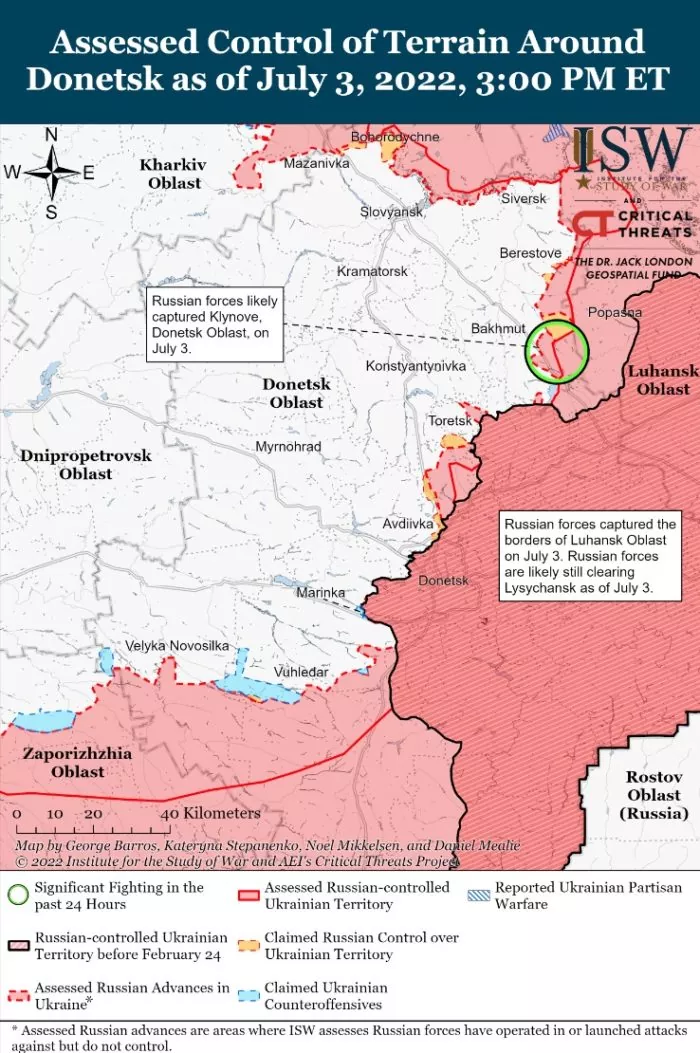
In the Donetsk direction, Russian forces groups are focused on the gradual displacement of units of the Defense Forces on the Siversk - Fedorivka - Bakhmut line.
- [Yesterday, In the Lysychansk direction, Russian forces were shelling from artillery in the areas of Zolotarivka and Verkhnokamyanka settlements. It led an assault against Zolotarivka and took control of the settlement.]
- In the Kramatorsk direction, after conducting artillery preparation, Russian forces forced the river Siverskyi Donets, and are entrenched in the areas of the settlements of Lysychansk and Bilohorivka. [Russian forces are trying to take possession of Bilohorivka. Fire continued to influence our troops to constrain their actions. Yesterday, artillery shelling was recorded near Hryhorivka and Bilohorivka.]
- In the Bakhmut direction, Russian forces intensified shelling of the positions of our troops with artillery and MLRS along the contact line. He inflicted massive rocket attacks in the areas of Pokrovske, Berestove, Spirne and the area of the Vuhlehirska TPP. [Yesterday, the occupiers were shelling the districts of Soledar, Pokrovske, Bakhmut, and Klynove with artillery.]
- With the support of artillery, Russian forces conduct offensive actions in the areas of the settlements of Vasylivka, Berestove, Spirne, Klynove, and Mayorsk, without success.
- [Yesterday, Ukrainian soldiers successfully repulsed offensive actions in the direction of Nyrkove - Berestove. Also, Russian forces unsuccessfully tried to carry out reconnaissance by fighting in the direction of Vasylivka - Berestove. Conducted assault operations in the Vovchoyarivka - Spirne and Mykolaivka - Spirne Suffered significant losses and withdrew.]
- In the Avdiivka and Kurakhivka directions, the occupiers carried out assaults in the direction of Pobieda and Mariinka Russian attack aircraft launched missile strikes in the areas of the eastern outskirts of Avdiivka and Mariinka.
- On the Novopavlivka and Zaporizhzhia directions, Russian forces carry out a systematic fire attack to restrain the units of the Defense Forces and prevent their transfer to other directions.
In the Pivdenny Buh and Tavriysky direction, the aggressor is focused on trying to regain lost positions in the areas of the settlements of Ivanivka, Potemkine, and Myrne, and preventing our troops from carrying out counteroffensive actions in the Kherson and Mykolaiv regions. Russian forces are improving the engineering equipment of the positions in the Novovoskresenske district.
- [The aggressor continues to launch missile attacks on military and civilian infrastructure facilities in the Mykolaiv direction to reduce the offensive capabilities of our troops.]
As part of the logistical support of the troops, 17 wagons with ammunition were moved from the temporarily occupied Crimea to the "Kalanchak" railway station (Myrne, Kherson oblast).
Three warships with Kalibr cruise missiles are in readiness for the use of missile weapons in the waters of the Black Sea.
The Ukrainian aviation and rocket artillery units continue to destroy ammunition storages and accumulations of manpower and military equipment of the Russian occupiers.”
Military Updates
After heavy fighting for Lysychansk, the Defense Forces of Ukraine were forced to withdraw from their occupied positions and lines, a statement from the General Staff of Ukraine reads. “In the conditions of the multiple superiorities of the Russian occupying forces in artillery, aviation, MLRS, ammunition and personnel, the continuation of the defence of the city would lead to fatal consequences. In order to preserve the lives of Ukrainian defenders, a decision was made to withdraw.
We continue the fight. Unfortunately, steel will and patriotism are not enough for success - material and technical resources are needed. The defenders of Luhansk oblast and other oblasts of our country heroically perform their civil and military duties. We will be back and we will definitely win!”
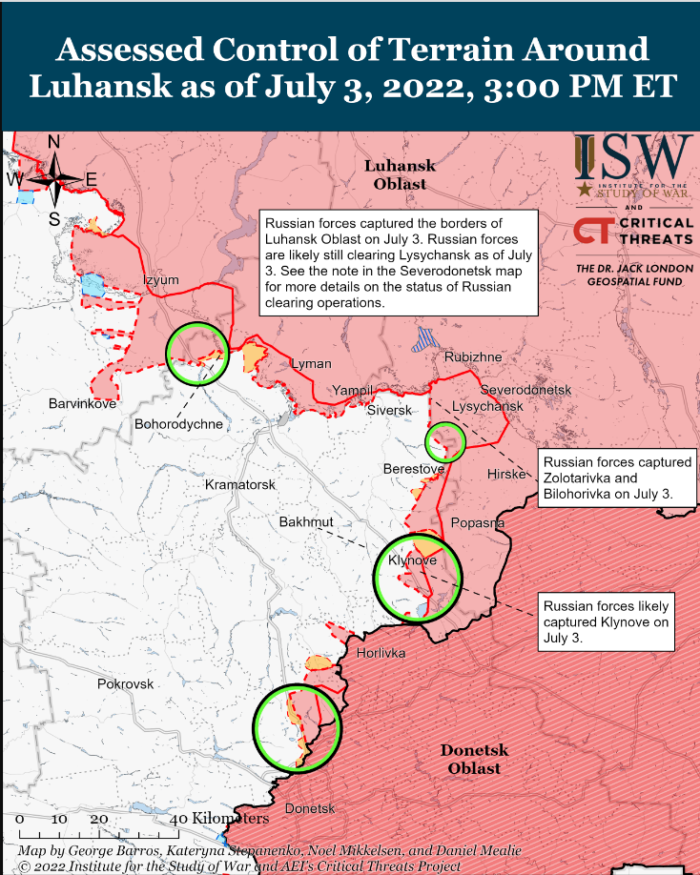
Luhansk Military Administration on Russian capture of Lysychansk: Russian troops outnumbered ours 10 to 1, Ukrainska Pravda reports. “In the fight for Lysychansk, Russian troops outnumbered the Ukrainian troops by around ten-to-one. The Russians are currently consolidating their positions in the city, [Serhii Haidai, head of the Luhansk Oblast Military Administration, wrote on
Telegram].”
https://twitter.com/EuromaidanPress/status/1543479385327636482
Ukrainian forces destroy Russian military base in Melitopol, Ukrinform reports, citing the Mayor of Melitopol, Ivan Fedorov. "Tonight, the Ukrainian Armed Forces destroyed one of the four military bases of the Rashists. They launched more than 30 strikes exclusively on the Russian military base, he wrote. On July 2, thanks to Ukrainian resistance forces, an armoured train with ammunition for the Russian troops derailed, Fedorov said.”
https://twitter.com/EuromaidanPress/status/1543718116357771265
According to British Defence Intelligence, (last 48 hours):
- Ukrainian forces have withdrawn from Lysychansk, likely falling back to prepared defensive positions. Russia’s Ministry of Defence had earlier claimed to have completed the encirclement of Lysychansk and secured full control of the city. Fighting in and around the city in Luhansk Oblast has intensified over the past week with Russian forces making steady progress.
- The city was the last remaining major population centre in Luhansk Oblast under Ukrainian control. Russia’s focus will now almost certainly switch to capturing Donetsk Oblast, a large portion of which remain under the control of Ukrainian forces. The fight for the Donbas has been grinding and attritional and this is highly unlikely to change in the coming weeks.
- With harvest underway, Russia’s invasion continues to have a devastating impact on Ukraine’s agricultural sector. The war has caused major disruption to the supply chains of seed and fertiliser which Ukrainian farmers rely on. Russia’s blockade of Odesa continues to severely constrain Ukraine’s grain exports. Because of this, Ukraine’s agricultural exports in 2022 are unlikely to be more than 35% of the 2021 total.
- Following its retreat from the Black Sea outpost of Zmiinyi (Snake) Island, Russia misleadingly claimed that ‘the ball is now in Ukraine’s court’ in relation to improving grain exports. In reality, it is Russia’s disruption of Ukraine’s agricultural sector which continues to exacerbate the global food crisis.
- Russian-backed officials have said they will hold a referendum on Kherson Oblast joining the Russian Federation by autumn 2022. Russia is likely prioritising a pseudo-constitutional vote in an attempt to legitimise its control of the region.
- On 28 June 2022, Ihor Kolykhaiev, the elected mayor of Kherson city, was arrested, highly likely in an attempt to suppress opposition to the occupation. However, widespread armed and peaceful resistance continues across occupied areas.
- Kherson is the region which has been brought under the new Russian occupation most comprehensively since February. Finding a constitutional solution for the occupation is likely a priority policy objective for Russia. It will highly likely be prepared to rig voting to achieve an acceptable result.
Losses of the Russian army
As of Monday 4 July, the approximate losses of weapons and military equipment of the Russian Armed Forces from the beginning of the war to the present day:
As of Monday 4 July, the approximate losses of weapons and military equipment of the Russian Armed Forces from the beginning of the war to the present day:
- Personnel – more than 36200 (+230),
- Tanks – 1589 (+5),
- Armoured combat vehicles – 3754 (+10),
- Artillery systems – 804 (+3),
- Multiple rocket launchers –MLRS - 246 (+0),
- Air defence means – 105 (+0),
- Aircraft - 217 (+0),
- Helicopters - 187 (+0),
- Automotive technology and fuel tanks – 2629 (+11),
- Vessels/boats - 15 (+0),
- UAV operational and tactical level – 658 (+4),
- Special equipment – 65 (+1),
- Mobile SRBM system – 4 (+0),
- Cruise missiles – 144 (+0)
Russian enemy suffered the greatest losses (of the last day) in the Sloviansk and Donetsk directions.
⚰️russia's combat losses in Ukraine as of July 4
▪ 36200 killed soldiers (+230)
▪ 1589 tanks (+5)
▪ 3754 APV (+10)
▪ 804 artillery systems (+3)
▪ 217 aircraft and 187 helicopters
▪ 15 boats and cutters #StopRussia #StandwithUkraine pic.twitter.com/o44ScMxigM— VoxUkraine (@voxukraine) July 4, 2022
Humanitarian
More than 10,000 Mariupol residents are being held in prisons in the temporarily occupied region of Donetsk – mayor, Ukrainska Pravda reports, citing the Mariupol City Council. "More than 10,000 Mariupol residents are in the prisons' of the so-called "DNR". Peaceful, civilian residents have been detained by the occupiers and sent to places of incarceration. Four such prisons are known: two in Yelenivka, the Donetsk pre-trial detention centre and Makiivka.
According to the mayor, the occupiers are keeping people in "terrible and inhumane conditions, like in a concentration camp" – 10 people each in closed cells 2 by 3 m. The Mariupol residents hardly get any water and food. They are not taken outside. They have no access to normal medical care and are subjected to various forms of torture – from psychological to physical. Boichenko called on the International Red Cross and the United Nations to address the matter of the illegal detention of civilians by the occupiers.
He also called on them to use all possible tools to obtain lists of prisoners, to achieve decent conditions for their detention and work together on the liberation of every resident of Mariupol.
OHCHR recorded 10,631 civilian casualties in Ukraine as of June 26 (no update). 4,731 were killed (including 330 children) and 5,900 injured (including 489 children).
️Environmental
Zelenskyy talks about what is needed to rebuild Ukraine, Ukrainska Pravda reported. Zelensky said that a special conference on Ukraine’s reconstruction will be held on Monday in Lugano, Switzerland, at which Ukraine will present its plan. Zelensky reported that the territory of 10 oblasts has been affected by hostilities since 24 February. Since then, 1,027 towns and cities have been liberated. Another 2,610 are still under Russian occupation, and most of them need to be rebuilt.
"It is necessary not only to restore everything that the occupiers have destroyed but to create a new basis for our life - safe, modern, comfortable, barrier-free. This requires huge investments, billions, new technologies, best practices, new institutions, and, of course, reforms. Ukraine will present its national vision on how to implement all of this on Monday in Lugano.
This is the largest economic project in Europe of our time and an extraordinary opportunity for every state and every company which we will invite to work in Ukraine.”
Legal
8 representatives of Ukrainian local authorities are in Russian captivity
, Ukrainska Pravda reports. “Eight Ukrainian heads of cities, village councils and amalgamated Territorial Communities (hromadas) are currently being held captive by the Russian Federation. According to the Association of Cities of Ukraine, these officials are from Zaporizhzhia, Kherson and Kharkiv oblasts.
As of 2 July 2022, the following Ukrainian officials are in the captivity of Russian occupying forces: Yevhenii Matvieiev - Dniprorudne city mayor; Oleksandr Shmyhol - Vilhivka village mayor; Oleksandr Babych - Hola Prystan city mayor; Ihor Kolykhaiev - Kherson city mayor; Valentyna Kostenko - Velyki Kopani village mayor; Dmytro Liakhno - Hornostaivka settlement mayor; Serhii Khilchenko - Khrestivka village mayor; Petro Zbarovskyi - Novotroitske settlement mayor.”
Ukraine says Russian ship carrying Ukrainian grain detained by Türkiye, Reuters reports. “Turkish customs authorities have detained a Russian cargo ship carrying grain which Ukraine says is stolen, Ukraine's ambassador to Türkiye said on Sunday. Ukraine had previously asked Türkiye to detain the Russian-flagged Zhibek Zholy cargo ship, according to an official and documents viewed by Reuters.
A Ukrainian foreign ministry official, citing information from Ukraine's maritime administration, told Reuters on Friday the 7,146 dwt Zhibek Zholy had loaded the first cargo of some 4,500 tonnes of Ukrainian grain from Berdiansk, a Russian-occupied port in south Ukraine.”
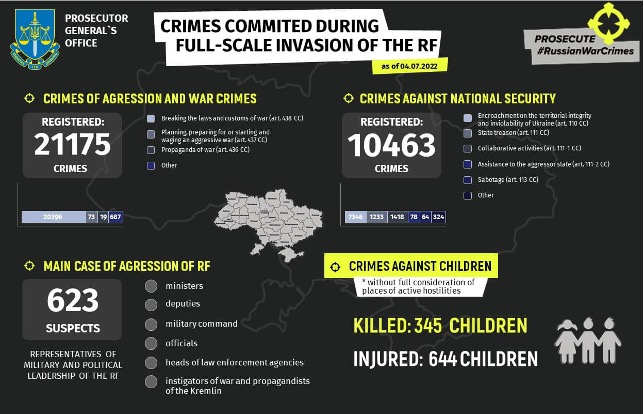
345 children were killed, and 644 children injured, the Office of the Prosecutor General of Ukraine reports as of July 4. 2,102 educational establishments are damaged as a result of shelling and bombings, 215 of them are destroyed fully. 21,175 crimes of aggression and war crimes and 10,463 crimes against national security were registered.
Support
The French region of Île-de-France offered to rebuild the destroyed Borodyanka as an ecological city
According to the President of the region, Borodyanka should become an ecological city with "systems working on modern energy-saving technologies" https://t.co/yIoTfavsHq pic.twitter.com/jctbtDh6hB
— Euromaidan Press (@EuromaidanPress) July 3, 2022
Slovakia planning to send MiG-29 fighter jets and tanks to Ukraine, Ukrinform reports. “Slovakia is planning to send MiG-29 fighter aircraft and tanks to Ukraine, whereas the Czech Republic will provide assistance to Slovakia in patrolling its territory until it receives US-made F-16s instead of the aircraft transferred to Ukraine.
The Prime Ministers of Slovakia and the Czech Republic, Eduard Heger and Petr Fiala, said this live on the Czech Republic's CT24 channel on Sunday, Ukrinform reports. "We will help Slovakia until it has new planes at its disposal. And we expect that someone will also help us if we have problems," Fiala said. He stressed that the West should provide weapons to Ukraine so that it can fight for its independence and European security. They are also fighting for us, Fiala said.”
Advanced US Arms Make a Mark in Ukraine War, Officials Say, The New York Times reports. “The most advanced weapons that the United States has so far supplied Ukraine are making an impact in their first several days on the battlefield, destroying Russian ammunition depots and command centres, American and Ukrainian officials say. Ukraine’s military had eagerly awaited the arrival of the first batch of truck-mounted, multiple-rocket launchers, whose satellite-guided rockets have a range of more than 40 miles, greater than anything Ukraine had possessed. The weapons have even won grudging respect from some Russians for their accuracy and power, analysts said.
Still, only four of the launchers, called High Mobility Artillery Rocket Systems or HIMARS, and their US-trained crews are in the fight, though four more are expected this month. Ukrainian officials say they need as many as 300 multiple-rocket launchers to combat Russia, which is firing several times as many rounds as Ukraine’s forces in the artillery-driven war of attrition in the country’s east.
Ukrainian soldiers are using their new weapon judiciously, firing one or two guided rockets at ammunition depots or command posts, often at night, and keeping them well away from the front lines to protect them, Pentagon officials and military analysts say. “So far they seem to be a quite useful addition,” Rob Lee, a Russian military specialist at the Foreign Policy Research Institute in Philadelphia and a former US Marine officer, said of the systems. “They will help hinder further Russian advances, but they won’t necessarily mean Ukraine will be able to take back territory.” […]
A senior Pentagon official said this week that the Ukrainians appear to be employing the HIMARS with deadly effectiveness and that the four additional systems would be deployed in “the near future.” […]
There is still a debate as to how many multiple-rocket launchers Ukraine needs. Mykhailo Podoliak, an adviser to President Volodymyr Zelensky of Ukraine, said in June that Ukraine needed 300 multiple-launch rocket systems and 500 tanks, among other things, to achieve battlefield parity — several times as much heavy weaponry as has been promised.
Michael G. Vickers, the Pentagon’s former top civilian official for counterinsurgency strategy, said the Ukrainians needed at least 60, and perhaps as many as 100, HIMARS or other multiple-launch rocket systems to win the artillery battle. “There are plenty available that could be supplied at minimal strategic risk,” said Mr. Vickers, who was the principal C.I.A. strategist for arming anti-Soviet forces in Afghanistan in the mid-1980s. […]
The transition to American-made rocket weapons was forced in part by the supply problems the Ukrainian army has faced. Ukraine has three types of Russian-made mobile rocket launchers, but ammunition for only the one with the shortest range is produced by its allies. Ammunition for Ukraine’s longer-range artillery rockets is made solely by Russia and Belarus.
For the HIMARS, Ukrainian forces rely on a guided rocket that is aided by GPS signals and accurate to within about 30 feet of its intended target. Before launch, a three-person crew input coordinates for each strike. […]
Besides firing long-range guided munitions, the wheeled HIMARS trucks have the advantage of speed. Not only can they drive quickly to a firing point, they can program targets while en route, launch their rockets singly or in a ripple of all six within a minute, and reload far faster than anything in use by the Russians. With 200 pounds of high explosives in each rocket, a HIMARS salvo can rival the devastating effect of an airstrike from a jet loaded with precision-guided bombs.”
https://twitter.com/EuromaidanPress/status/1543578784988897288
New Developments
Ukraine's official fundraising platform U24 is assembling an "army of drones"
The goal is to crowdfund 200 tactical UAVs & thousands of simpler ones. You can donate $ or "dronate" your own drone https://t.co/yOJQjQIZHi pic.twitter.com/NqaTXe4dTw
— Euromaidan Press (@EuromaidanPress) July 4, 2022
- Ukraine president's adviser names conditions for the resumption of talks with Russia, Ukrinform “Mykhailo Podoliak, an adviser to the head of the President's Office, has responded to the Kremlin's statements about the resumption of negotiations, providing a list of conditions under which Ukraine is ready to sit down at the negotiating table again. Ceasefire. Z-troops withdrawal. Returning of kidnapped citizens. Extradition of war criminals. Reparations mechanism. Ukraine's sovereign rights recognition. The Russian side knows our conditions well. Peskov's boss may not worry: the time will come and we will record them on paper, he said.
Russian presidential press secretary Dmitry Peskov earlier said that Ukraine must understand Russia's conditions, agree to them, sit down at the negotiating table, and sign a document
."
- Ukraine security guarantees will not be the same as for NATO members, German Chancellor Scholz says, Reuters "We are discussing with close friends the question of the security guarantees we can give. This is an ongoing process. It is clear that it will not be the same as if someone were a member of NATO, Scholz said.”
- It’s up to Ukraine to decide when it will sit down at negotiating table with Russia – Steinmeier, Ukrinform reports, citing UAand ZDF. "It’s an open question how exactly the war will end. The war is now being waged on the battlefield, but there must be a prospect for negotiations. It’s only up to Ukraine to decide when it will sit down at the negotiating table, President of Germany Frank-Walter Steinmeier said.”
- Lukashenka accused Ukraine of shelling Belarus and ordered to "put” opponents’ capitals “at gunpoint”, Ukrainska Pravda reports, citing BelTA. “Oleksandr Lukashenka, the self-proclaimed president of Belarus, accused Ukraine of launching missiles on the territory of Belarus and ordered his military to "put the capitals’ decision-making centres of Minsk's opponents at gunpoint".
- Russian defence minister tells Putin Ukraine's Luhansk region has been 'liberated', Reuters “Russia's Defence Minister Sergei Shoigu informed President Vladimir Putin that all of Ukraine's Luhansk region had been "liberated" by Russian and [so-called] separatist forces, the defence ministry said on Sunday.”
- S. senator says NATO countries could become Russia's next target if Putin succeeds in Ukraine, Ukrinform reports, citing Guildhall. “If Ukraine is not protected, a NATO member country may become the next object of Russian aggression, which will lead to direct military intervention by the United States of America. This was stated by US Senator Kevin Cramer (R-ND), a member of the Senate Committee on Armed Services.”
- Moscow blames Ukrainian missile attack for deaths in south Russian city, Reuters “At least three people were killed and dozens of residential buildings damaged in the Russian city of Belgorod near the Ukraine border, the regional governor said, in what Moscow said was a Ukrainian missile attack. Reuters could not independently confirm the claims.” [ME: Russia has been accused of conducting many False-Flag operations. It will do whatever it takes to stop the West from delivering long-range weapons to Ukraine and to mobilise Russians behind its war. These kinds of attacks only serve one party’s interests and it's not Ukraine.]
- https://twitter.com/EuromaidanPress/status/1543746410633379840
Assessment
- On the war.
The Institute for the Study of War has made the following assessment as of Saturday 4 July, 2022:
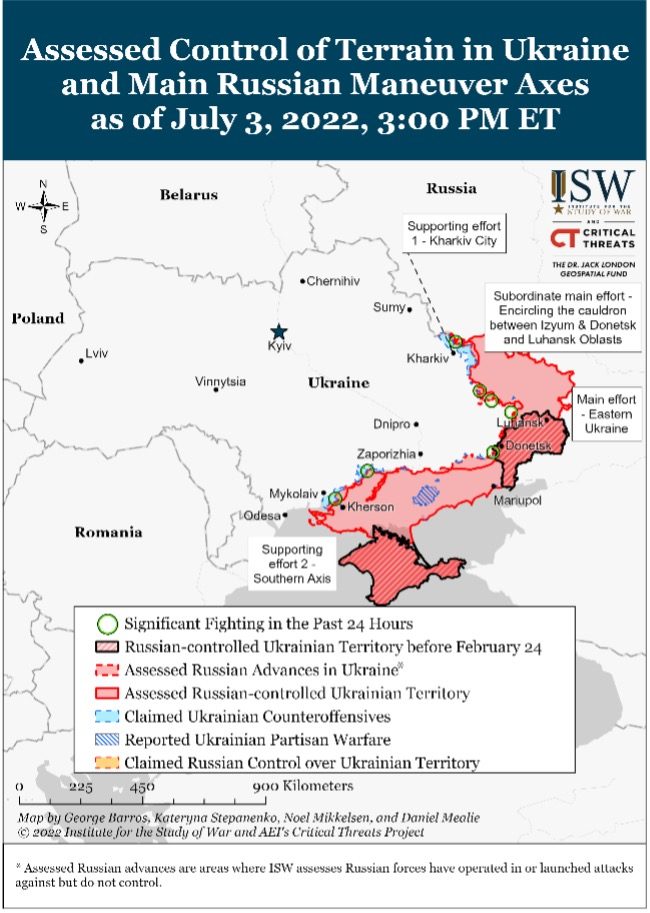
“Russian forces have likely secured the Luhansk Oblast border, although pockets of Ukrainian resistance may remain in and around Lysychansk. Russian Defense Minister Sergey Shoigu announced that Russian forces have captured Luhansk Oblast on July 3, after seizing Lysychansk and settlements on the Luhansk Oblast administrative border. The Ukrainian General Staff also announced that Ukrainian forces withdrew from Lysychansk to avoid personnel losses. Russian forces have likely not fully cleared Lysychansk and Luhansk Oblast as of July 3, despite Shoigu’s announcement. The Russian Defense Ministry stated that Russian forces are still fighting within Lysychansk to defeat the remaining encircled Ukrainian forces, but the Ukrainian withdrawal means that Russian forces will almost certainly complete their clearing operations relatively quickly.
Russian forces will likely next advance on Siversk, though they could launch more significant attacks on Bakhmut or Sloviansk instead or at the same time. Ukrainian forces will likely continue their fighting withdrawal toward the E40 highway that runs from Sloviansk through Bakhmut toward Debaltseve. It is unclear whether they will choose to defend around Siversk at this time.
Two very senior Russian commanders are reportedly responsible for the tactical activities around Lysychansk. Commander of the Central Military District Colonel-General Aleksandr Lapin and Commander of the Russian Aerospace Forces Army General Sergey Suvorikin (who also commands Russia’s “southern” group of troops in Ukraine) have been responsible for securing Lysychansk and the area to the west of it respectively. The involvement of two such senior officers in the same undertaking in a small part of the front is remarkable and likely indicates the significance that Russian President Vladimir Putin has attributed to securing Lysychansk and the Luhansk Oblast border as well as his lack of confidence in more junior officers to do the job.
Ukrainian forces likely used US-provided HIMARS rocket artillery systems to strike a Russian ammunition depot at the Melitopol airfield on July 3. Melitopol Mayor Ivan Fedorov reported that Ukrainian forces launched two strikes on one of the four Russian depots in Melitopol. Russian Telegram channel Rybar released footage of a large cloud of smoke over the city, and Russian-appointed Melitopol Governor Yevhen Balytskyi falsely claimed that Ukrainian forces aimed to strike residential buildings, but instead hit areas around the airfield.
The Kremlin likely seeks to expand Russian state control over private Russian companies that support elements of Russia’s military industrial base. The Ukrainian Military Intelligence Directorate (GUR) reported on July 3 that the Russian government’s inability to pay Russian firms supporting Russia’s war in Ukraine is degrading Russia’s ability to repair damaged vehicles. The GUR reported that the directors of Russian military vehicle repair centers are not accepting new Russian equipment for repair because the Russian military has not paid these centers for previous work. Recently proposed Russian legislation suggests that Kremlin leadership shares GUR’s assessment. Russian legislators in the Russian State Duma submitted a bill on June 30 that would empower the Kremlin to introduce “special measures in the economic sphere” enabling the Russian government to force private Russian companies to provide supplies for Russian military operations. The bill prohibits Russian businesses from refusing to fulfil Russian government procurement orders connected to Russian military operations.
Key Takeaways
- Russian forces seized the remaining territory between Lysychansk and Luhansk Oblast’s administrative borders on July 3.
- Russian forces launched assaults northeast of Bakhmut and north of Sloviansk but did not secure new territorial gains.
- Russian forces conducted extensive artillery attacks in the western part of the Southern Axis likely to disrupt Ukrainian counteroffensives.
- The Kremlin continued to set conditions for the potential Russian annexation of proxy Republics.
Ukrainian partisans reportedly derailed a Russian armored train carrying ammunition near Melitopol on July 2.
Russia Steps Up Pace of Missile Attacks on Residential Targets, The New York Times reports. “The pace of Russia’s strikes on civilian targets, often with outdated and imprecise missiles, is picking up, Ukrainian and Western officials, as well as Russian analysts, say, as its forces run low on more sophisticated weapons in their struggle to make progress in the fifth month of the conflict.
The Ukrainian president, Volodymyr Zelensky, said Friday night that the Russian forces had lobbed more than 3,000 missiles at Ukraine in four months of the war. Over 200 missiles were fired on Ukrainian government-controlled territory in the second half of June, more than double the number in the first half of the month, Ukrainian Brig. Gen. Oleksii Hromov said at a news conference on Thursday. […]
On Saturday, Russian forces pushed into Lysychansk, the last city in the eastern Luhansk province that remained outside Russian control, according to Moscow’s state news agency, social media posts by pro-Russian forces and a Ukrainian soldier stationed in the city. Both sides said fighting is ongoing in parts of the city.
Military analysts warn Russia now faces the difficult task of maintaining its slowing offensive into the neighboring Donetsk province to achieve its stated war aim of capturing Ukraine’s eastern Donbas region as its losses mount. […] “Moscow doesn’t want to end the war, but it needs to catch its breath to heal wounds and partly replenish its weapons stock,” [Pavel Luzin, a Russian military analyst] said.
More broadly, Ukrainian officials are warning that the sharp rise in civilian attacks could signal a new phase of the war, as Russia tries to make up for its shrinking military capacity with attempts to degrade Ukrainian morale.
“The Russians have moved to the concept of war where they want to create large-scale panic in Ukraine,” Mykhailo Podoliak, an adviser to Mr. Zelensky, told the Ukrainian television station Channel 24 on Saturday. He said Russia was doing it to pressure the Ukrainian government to cede territory in exchange for peace, allowing the Kremlin to claim victory.”
Lviv is preparing for a potential attack from Belarus, Ukrainska Pravda reports, citing the Mayor of Lviv, Andrii Sadovyi. “Sadovyi has called an operational meeting with the participation of the military and civilian leadership of Lviv. "We discussed the defence plan and the forces and means that come under the jurisdiction of the city. The situation is changing, so our defence strategies also need to be changed and updated.
A defence headquarters will be set up in each district of the city and additional training will be conducted for members of volunteer terrorist defence units. Until we put them on round-the-clock duty. But this decision can change at any time.
We are also considering the option of forming reserve volunteer battalions from employees of the city council and municipal enterprises. We are continuing to form a strategic reserve of provisions in case supply routes are blockaded."
No threat of attack from Belarus now – Denysenko, Ukrinform reports. "Mobilization exercises in Belarus. So far, it does not mean that a mass mobilization campaign has begun in Belarus and the Belarusian army has started moving its forces to the Ukrainian border. At the moment, it is not the case, but unfortunately, we cannot rule out that such decisions may be made after some time. As of now — tomorrow or the day after tomorrow — there is no threat of an attack," Vadym Denysenko, an adviser to the Ukrainian interior minister, said.
According to Denysenko, the self-proclaimed Belarusian president, Lukashenka, is in a situation when sociological studies show that about 80% of Belarusians do not want a war with Ukraine. On the other hand, Lukashenka is economically completely dependent on the Russian Federation.
"His speech today showed that he is incredibly scared. He is incredibly disturbed about something, he says things that Putin would like to hear, but at the same time, he did not say that if necessary, his army will start fighting," he said.
On July 3, Lukashenka said that Belarus supports Russia and is building a "union state" with the Russian Federation. According to him, a "unified grouping of armed forces" was created long ago in the union of Belarus and Russia, and the participation of Belarus in Russia's "special operation" was determined by him a long time ago.
Russia could go for another offensive on Kyiv if certain conditions arise - Interior Minister’s advisor, Ukrinform reports, citing Vadym Denysenko, an advisor to the Minister of Internal Affairs of Ukraine, who spoke with RBC-Ukraine. “Russian troops may resume the offensive on Ukraine’s capital Kyiv if Belarus forces join the invasion or if the Ukrainian forces are destroyed on the eastern front.
"The first case is if Aliaksandr Lukashenka agrees to deploy the Belarusian army here. So far he’s been dodging that, stopping short of approving such a move. The second option, that’s if Lukashenka doesn’t agree to this, an attack on Kyiv is possible only after the Ukrainian group in the east of Ukraine is completely destroyed," the advisor suggested.
As Ukrinform reported earlier, referring to the Ministry of Defense, there are no signs of preparations for another offensive of enemy forces from the territory of Belarus, but such a threat remains in place so the Ukrainian Army keeps part of its troops on the country’s north to cover the border areas. According to Ukraine’s defence intelligence, the Belarus army command as of July 1 has massed seven battalions on the border with Ukraine.”
Russia’s use of older missiles suggests its stock of precision weapons is low, analysts say, The New York Times reports. “Some of the deadliest Russian missile strikes of the war have rained down on civilian targets over the last two weeks, and many of the attacks were carried out with outdated missiles designed for naval operations.
Two of those weapons — Soviet-era Kh-class missiles — slammed into a shopping centre in Kremenchuk on Monday, killing dozens. The same type of missile ripped into an apartment building in the Black Sea resort of Serhiivka on Friday, leaving at least 21 dead. Military analysts say the use of such older, imprecise weapons, which is rapidly driving up the civilian death toll, suggests Russia may be running short of long-range precision missiles, just as Ukraine is starting to receive more heavy weaponry from NATO.
Soviet Kh-class missiles, designed to target ships, entered the country’s arsenal in the 1960s, and Russia’s reliance on them is evidence it does not have large numbers of more modern weapons available.
“Russia continues to employ air-launched anti-ship missiles in a secondary land-attack role, likely because of dwindling stockpiles of more accurate modern weapons,” the British defence ministry said in its July 2 assessment. Pavel Luzin, a Russian military analyst, said Moscow’s reliance on Kh-class missiles “to terrorize the Ukrainian cities from the air serves as yet more evidence of Russia’s falling stocks of long-range precision munitions.”
The Ukrainian president, Volodymyr Zelensky, said Friday night that the Russian forces had lobbed more than 3,000 missiles at Ukraine in four months of the war. Ukrainian intelligence officials have estimated Russia has used up 60 percent of its stockpile of high-precision weapons.
Russia’s growing use of Kh-class missiles, with a range of 50 to 200 miles, has coincided with rising estimates of Russian military casualties by Western intelligence agencies. The British defence chief, Ben Wallace, said this past week that 25,000 Russian soldiers had been killed in the war. US officials have put the number of Russian dead at 15,000.
2. Consequences and what to do?
Hans Petter Midttun:
I struggle to understand NATO's strategy on Ukraine.
According to its past and present strategic concept, “NATO is determined to safeguard the freedom and security of Allies. Its key purpose and greatest responsibility is to ensure our collective defence, against all threats, from all directions.”
After nearly 15 years of Russian transgressions of international law – including attacking Georgia in 2008 and Ukraine in 2014, as well as waging a hybrid war against the USA and Europe for years – the Alliance has finally concluded that “the Euro-Atlantic area is not at peace. The Russian Federation has violated the norms
After nearly 15 years; in the face of continuous and open aggression and after constant calls for action by the Eastern and Central European countries.
On the eve of the NATO summit in Madrid, the Lithuanian President, Gitanas Nauseda, said that “The war [in Ukraine] has fundamentally challenged the security architecture of the West. Russia has been publicly challenging the West for at least the past 15 years. It has tried to gain the upper hand through aggressive action, first in Georgia in 2008, then in Ukrainian Crimea and Donbas in 2014. Despite all this, some Western countries have continued business as usual with Moscow, some even expanding their cooperation. For decades, the West has failed to understand what Russian President Vladimir Putin’s regime is about — namely expansionism, revisionism, violence, rule by fear and coercion. Russia is not interested in creation or cooperation, but rather in destruction and rule by force. The time has come to understand that Russia cannot be stopped by persuasion, cooperation, appeasement or concessions. Russia takes such gestures as a sign of weakness, as permission to expand and intensify its onslaught. Putin is clear in his desire to subvert Western values, cut the links between North America and Europe, and subdue Europe to Russia’s will.”
He concluded that NATO must make sure Ukraine wins. He echoes the sentiments of most European leaders who have experienced the Russian “world” and were “de-occupied” during the last 30-35 years only. This is why Poland submitted a proposal for a peacekeeping mission in Ukraine, why Poland, the Czech Republic and Slovenia put forward a plan to save Ukraine, and why Slovakia is planning to send MiG-29 fighter jets and tanks to Ukraine.
They all recognise that Ukraine is fighting for us, for Europe, for freedom, and for peace in Europe. But still, NATO does not fully acknowledge the Ukrainian contribution to European security. It does not establish the obvious link between its mission to safeguard the freedom and security of its member states, and the war Ukraine is fighting on our behalf.
Western support is slow and half-hearted. While Ukrainian units have lost 30-50% of their heavy equipment and are slowly running out of ammunition for its soviet legacy artillery, its international partners are providing support slowly, reluctantly and in low numbers. Until now, we have even denied supplying Ukraine with the tools it needs to re-establish control of its airspace, stop Russia from launching missile attacks against its cities and break the maritime blockade. NATO member states are not providing the weapons Ukraine needs to win. Worse still, recognising that the independence and sovereignty of Ukraine are being decided in the Sea of Azov and the Black Sea – where the economic foundation of the state is being undermined – NATO is presently not even providing the support it needs to avoid defeat.
Struggling to understand NATO’s strategy on Ukraine, I find it useful to outline some of the consequences of its present “inaction”.
If the West is not providing the tools needed to defeat Russia militarily and evict them from Ukraine, this might be conceived as an acceptance of the “status quo”. NATO is apparently accepting – not in words, but in deeds – that Russia will remain in control over Luhansk, Donetsk, Zaporizhzhia, Kherson, Crimea and the Black Sea. As repeatedly argued, this will ultimately lead to the defeat of Ukraine. Equally, important, it also means that the war will continue for years. While Ukraine might falter, Ukrainians will not. As a consequence, NATO/EU will have an armed conflict at its border for decades to come.
But that is only the start of a long list of consequences. We are facing a global famine because of Russia’s war on Ukraine. A protracted war and the “tsunami of ripple effects” will affect the lives of billions, motivating voters to “punish” the ruling parties responsible for their demise, potentially completely changing the political landscape in the USA and Europe. Increased poverty and hunger will lead to increased extremism and terrorism globally. By not challenging Russia in the Black Sea, international Freedom of Navigation is at risk, potentially impairing maritime trade. Stepping back instead of confronting Russia, strengthen the Russian (and possibly Chinese) perception of the West as weak, further eroding NATO deterrence at the cost of our common security. Having demonstrated the effectiveness of the nuclear “fait accompli” strategy, more countries and regimes will be motivated to build a nuclear arsenal at any cost. More crucially, failing to address the Russian “fait accompli” strategy is a demonstration that it works, which might embolden Russia to continue its aggressive foreign policy until it takes “a bridge too far”.
It is impossible to believe that NATO is wishing for any of these outcomes. Quite the opposite, they are all in direct conflict with its mission to safeguard the freedom and security of its member states.
So why chose a strategy that ensures a drawn-out war when the consequences run contrary to both NATO’s and the member states' interests?
The present strategy only makes sense if a protracted war is seen as a “positive outcome” or the lesser of evils.
In my humble opinion, a protracted war only becomes a “positive” outcome if NATO needs more time. More time to generate new forces, procure more arms, sensors, command and control systems, build sustainability, and not least, rebuild the defence industry to achieve all of this. Time might be crucial if NATO is facing shortcomings after decades of underbudgeting, streamlining and downsizing.
It is possible the Alliance and its member states need more time to prepare themselves for a confrontation that has already started.
Unfortunately, we must also face up to the possibility that the present situation is a result of a lack of strategy altogether.
During President Bidens press conference one month after the Russian invasion started, he stressed his most important objective was to have absolute unity among NATO allies on 3 key important issues, (1) to support Ukraine with military and humanitarian assistance, (2) to impose the most significant economic sanctions ever to cripple Putin’s economy and punish him for his actions, (3) and fortify the eastern flank of NATO. The Alliance had accomplished all three of these, President Biden stated on 24 March. During a press conference by NATO Secretary-General, Jens Stoltenberg, on the same day, he highlighted that NATO is determined to do all it can to support Ukraine.
More than 3 months later, the outcome is becoming increasingly clear for all to see. Western support is slow and half-hearted.
Deputy Secretary-General of NATO, Mircea Geoană, recently helped explain why when he described the division of labour between NATO and its allies. He argued that NATO took a deliberate decision to provide Ukraine with nonlethal support only, while the individual member states support Ukraine with lethal military equipment.
The statement of both Biden and Stoltenberg, the division of labour, the difference in strategic understanding between Eastern and Western Europe, and not least, the huge difference in practical support rendered by the individual member state demonstrates discord within the Alliance. NATO ambitions are being defined by its “weakest links”.
While the lack of resolve might be the result of a genuine fear of triggering a “full-fledged war between NATO and Russia”, an acknowledgement of own capability gaps, or a recognition of the fundamental dependency of many European countries on Russian oil and gas, the outcome is the same: NATO is rendered unable to act according to its last strategic concept and fully meet its commitment to “safeguard the freedom and security of Allies”.
That mission does not start at its borders. If it did, NATO deterrence would already have failed and we would be engaged in a war that we could have avoided.
Maybe, just maybe, NATO needs time to unite its member states around a strategy that will end the war by ensuring a Ukrainian victory.





